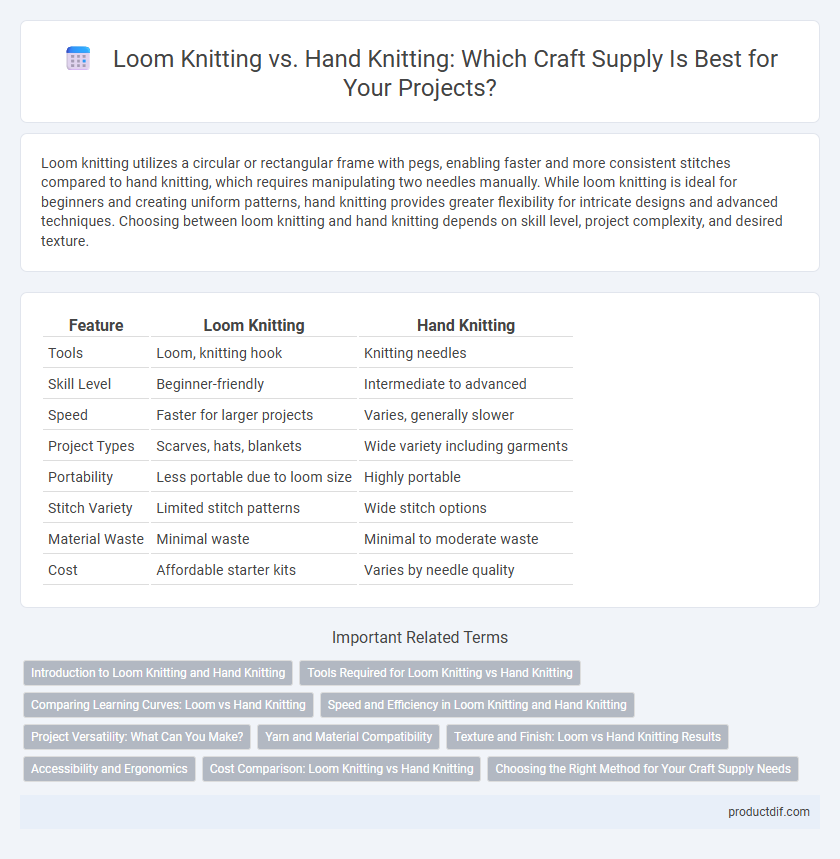Loom knitting utilizes a circular or rectangular frame with pegs, enabling faster and more consistent stitches compared to hand knitting, which requires manipulating two needles manually. While loom knitting is ideal for beginners and creating uniform patterns, hand knitting provides greater flexibility for intricate designs and advanced techniques. Choosing between loom knitting and hand knitting depends on skill level, project complexity, and desired texture.
Table of Comparison
| Feature | Loom Knitting | Hand Knitting |
|---|---|---|
| Tools | Loom, knitting hook | Knitting needles |
| Skill Level | Beginner-friendly | Intermediate to advanced |
| Speed | Faster for larger projects | Varies, generally slower |
| Project Types | Scarves, hats, blankets | Wide variety including garments |
| Portability | Less portable due to loom size | Highly portable |
| Stitch Variety | Limited stitch patterns | Wide stitch options |
| Material Waste | Minimal waste | Minimal to moderate waste |
| Cost | Affordable starter kits | Varies by needle quality |
Introduction to Loom Knitting and Hand Knitting
Loom knitting utilizes a frame or loom to create knit fabrics, offering a quicker and more accessible alternative to traditional hand knitting, which relies on knitting needles and intricate hand movements. Hand knitting allows for greater versatility and customization in stitch patterns and textures, appealing to experienced crafters seeking detailed designs. Both techniques enable the creation of scarves, hats, and blankets, but loom knitting is particularly favored for its ease of use and efficiency in producing consistent stitches.
Tools Required for Loom Knitting vs Hand Knitting
Loom knitting requires a specialized loom tool, typically made of wood or plastic with pegs arranged in a circular or rectangular shape, along with a hook to lift yarn over pegs. Hand knitting demands only knitting needles, available in various sizes and materials like bamboo, metal, or plastic, plus yarn. The loom simplifies stitch formation for beginners, while hand knitting provides more versatility with stitch patterns but requires more skill and dexterity.
Comparing Learning Curves: Loom vs Hand Knitting
Loom knitting offers a gentler learning curve for beginners due to its repetitive motions and structured pegs, making it easier to grasp basic stitches quickly. Hand knitting requires mastering needle coordination and stitch techniques, which may take longer to develop but allows for greater creative flexibility and advanced patterns. Choosing loom or hand knitting depends on balancing ease of learning with the desired complexity of finished projects.
Speed and Efficiency in Loom Knitting and Hand Knitting
Loom knitting significantly increases speed and efficiency by enabling crafters to produce projects faster than traditional hand knitting, thanks to its simple, repetitive loops formed on a fixed frame. Hand knitting offers greater precision and intricate stitch variation but is generally slower, requiring more time and manual dexterity to complete each row. For large projects or beginners, loom knitting provides an accessible, time-saving alternative without sacrificing basic stitch quality.
Project Versatility: What Can You Make?
Loom knitting enables rapid creation of bulky items like scarves, hats, and blankets, ideal for beginners and quick projects. Hand knitting offers intricate stitch patterns and finer gauge options, perfect for detailed garments and accessories such as sweaters and lace shawls. Both methods provide unique versatility, with loom knitting favoring speed and simplicity, while hand knitting excels in customization and texture complexity.
Yarn and Material Compatibility
Loom knitting accommodates a wide range of yarn types, including bulky, wool, cotton, and synthetic blends, making it ideal for beginners seeking consistent tension and faster project completion. Hand knitting offers greater flexibility with materials, allowing crafters to manipulate delicate fibers like lace-weight mohair or intricate cable designs using diverse needle sizes. Both techniques benefit from natural fibers for breathability and durability, though loom knitting favors sturdier yarns to withstand the repetitive tension of the loom.
Texture and Finish: Loom vs Hand Knitting Results
Loom knitting produces a consistent, uniform texture ideal for creating dense, even fabrics, while hand knitting offers greater variation in stitch tension and texture, resulting in a more personalized, artisanal finish. The interlocking stitches from loom knitting create a smooth, tight surface often preferred for structured items, whereas hand knitting's flexibility allows for intricate patterns and a softer, more textured finish. Choosing between loom and hand knitting depends on the desired fabric density, texture uniformity, and overall aesthetic of the final craft project.
Accessibility and Ergonomics
Loom knitting offers greater accessibility for individuals with limited dexterity or arthritis due to its ergonomic design that reduces strain on fingers and wrists. Hand knitting requires fine motor skills and can cause discomfort during prolonged use, making it less suitable for those with physical limitations. The fixed loom structure supports consistent tension and easier manipulation, enhancing overall comfort and usability compared to traditional hand knitting needles.
Cost Comparison: Loom Knitting vs Hand Knitting
Loom knitting generally incurs lower initial costs due to affordable loom kits ranging from $10 to $50, making it accessible for beginners. Hand knitting requires investment in quality yarns and sets of knitting needles, which can cost $15 to $100 or more based on materials and brand. Overall, loom knitting offers a budget-friendly entry point, while hand knitting can become more expensive depending on choice of tools and yarn quality.
Choosing the Right Method for Your Craft Supply Needs
Loom knitting offers speed and uniformity, ideal for large projects and beginners using craft supplies such as yarn and looms. Hand knitting provides greater versatility and intricate patterns, perfect for detailed work with varied textures and stitches. Selecting between loom knitting and hand knitting depends on the desired project complexity, available tools like knitting needles or looms, and personal skill level in handling craft materials.
Loom Knitting vs Hand Knitting Infographic

 productdif.com
productdif.com